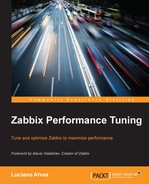In the next box, we have a previously made announcement, which is a very important one—the introduction of active checks. Nowadays, people don't recognize the importance of this feature.
I've been holding training sessions since 2009 (I've been an official Zabbix trainer since 2012). In all of those training sessions, when I was talking about the power behind active items, there were some guys getting surprised in almost every session. It happens that the default templates released by Zabbix SIA are created to be easy to try with Zabbix. We shouldn't use these templates in a production environment. We should create our own templates based on them.
The default templates released with Zabbix sources don't use active items. Why? It's too simple and obvious: active items are not so simple to configure. They are not "plug-and-play". Passive items are "plug-and-play", and that is better for new Zabbix users to get to know about Zabbix's features.
Let's think a little about data gathering using the Zabbix agent (with active or passive items). When we are trying to gather some data using the Zabbix agent, we can choose between the Zabbix agent and Zabbix agent (active) item types. Each one has its pros and cons.
Let's say that you have 1,000 hosts and each host has 10 passive items for gathering data. In this scenario, the Zabbix server will manage a 10,000 item queue.
Let's say you have 1,000 hosts and each host has 10 active items for gathering data. In this scenario, the Zabbix server will send a 10 item queue to each host.
Of course, it is cheaper to let each Zabbix agent manage a little queue with 10 items than let a Zabbix server manage a huge queue with 10,000 items.
Another goal of active items is to create a buffer on the Zabbix agent side before sending the values to the Zabbix server. In this way, we'll have a lower number of TCP connections. The network managers will thank you for this.
The active agent buffer is very useful in the event of network errors. Your gathered values aren't lost, as in the case of passive items, but the agent will retry to send them.
To know some things more about buffering on the Zabbix agent side, you need to check out the Zabbix agent's configuration file and search for the parameters that are involved with this feature:
BufferSend: This can use values between 1 and 3,600 seconds. By default, the Zabbix agent starts with 5 seconds. In this scenario, it will delay data delivery to the Zabbix server untilBufferSendreaches its time orBufferSizeis full. Some environments will be okay with using 10 seconds or highervalues.BufferSize: This can use numbers between 2 and 65,535. By default, the Zabbix agent starts with 100 values. In this scenario, it will delay data delivery to the Zabbix server untilBufferSizeis full orBufferSendreaches its value.
As you can see, we can reduce the load on the Zabbix server and the TCP connections amount if we start using active items with the Zabbix agent.
What item types are you using? Let's go and change it to start reducing the load on the Zabbix server and network.
